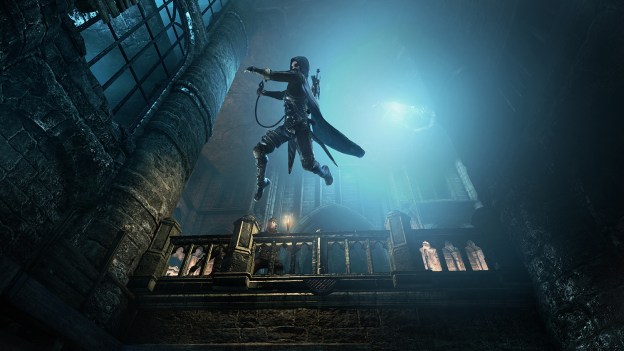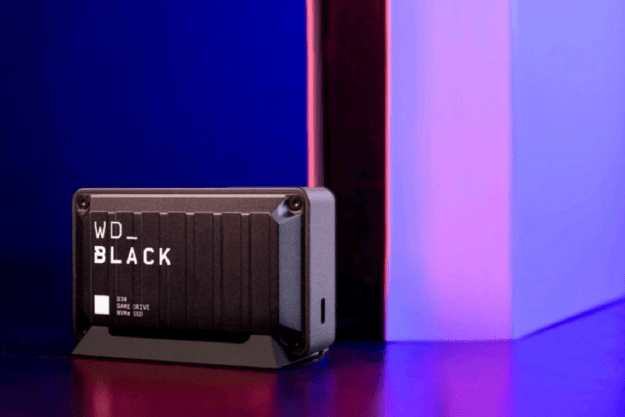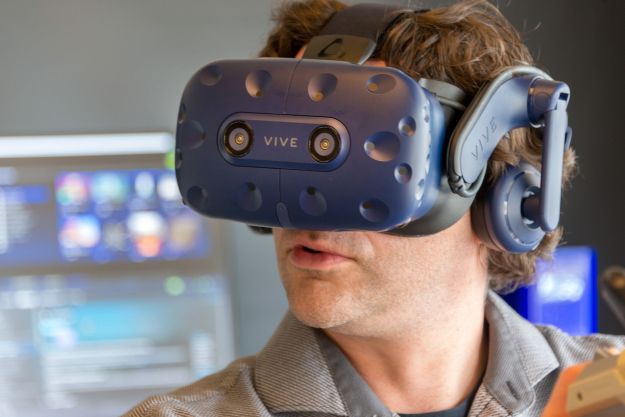 Eidos Montreal’s Thief is going to have a tough time if it wants avoid being thought of as a spiritual companion to Arkane Studios’, Dishonored. Of course, the late 2012 hit was itself inspired by the Thief games of old, so comparing the two is pretty much the same thing as saying that the spirit of the classic series lives on in this latest iteration. Go figure.
Eidos Montreal’s Thief is going to have a tough time if it wants avoid being thought of as a spiritual companion to Arkane Studios’, Dishonored. Of course, the late 2012 hit was itself inspired by the Thief games of old, so comparing the two is pretty much the same thing as saying that the spirit of the classic series lives on in this latest iteration. Go figure.
With the new entry into the series, Thief continues to be a game of stealth and discovery. Returning protagonist Garrett slips along through shadows as he roots out items of value, whether it’s priceless objects, information, or cold, hard currency. Much that once was still is. Players are thrust into an adventure set in the nameless City, a steampunk-inspired marvel of architectural design (and poor security planning.) Garrett’s toolbox is a bit larger than before, but mostly familiar. The technical bells, whistles, and contrivances of modern-day gaming platforms – specifically, next-gen hardware – are put to use in creating a more believable and immersive experience, but Eidos’ mandate to reinvent the IP did not include a genre swap. Thankfully.
The hands-off demo begins with a stealthy infiltration into the City. We’re not told why Garrett must sneak his way in, but he does so in an on-rails sequence that sees him peering through the space between the wooden slats of a rolling cart. The scene serves as an introduction to the City, which still grips tightly to the “Middle Ages noir” vibe that characterized the previous games. There’s considerably more detail now, of course, with guards jabbering about the local happenings and the daily rhythms of commerce unfolding along the sides of the narrow, lamp-lit cobblestone streets.
“You’re going to see that the City really is a character by itself.”
“You’re going to see that the City really is a character by itself. There is a progression,” producer Stephane Roy told Digital Trends. The description of the City’s progression sounds a bit like the High/Low Chaos levels of Dishonored and how your behavior in that game impacted the city, but Thief‘s approach is more organic. It’s less a gameplay mechanic and more a general feeling that your actions within the City are impacting the larger world.
Eidos sees the mission-to-mission play as breaking down into three basic components: infiltration, thievery, and escape. “Infiltration is really where you’re going to play with the AI, mouse-and-cat gameplay,” Roy said. We see some of that play out in the demo, with Garrett using both his own tools and objects in the environment to toy with the human obstacles he encounters. At one point, he uses his custom compound bow to fire an arrow into a nearby room situated just behind one of two guards who stand facing each other.
As the more distant and now distracted guard moves to the other room to investigate, Garrett quickly blackjacks the closer one into unconsciousness and then fires an arrow into a button on the wall that drops a portcullis down, locking the still-conscious first guard into the adjacent room. Garrett then slips through the nearby doorway that his target left through minutes earlier, and as he proceeds into the shadows the confused and trapped guard first notices his unconscious partner. He shouts for help, but none will come. It wouldn’t matter anyway; Garrett is already in the clear.
Mechanically, Thief looks immediately familiar to fans of the series. The game communicates Garrett’s concealment to players with an overlay of black, roiling fog at the fringes of the screen. A new swoop move allows Garrett to quickly dart ahead in one direction, fast enough that he can slip between nearby shadows without being noticed. Provided of course, that no one is already looking.
In addition to the swoop mechanic, players will also have the opportunity to call on Focus abilities. The meter-managed powers effectively enhance Garrett’s existing skills as a master thief. You can use it to peer around the environment (much like Arkham City‘s Detective mode) to highlight points of interest and spot hidden items and runes that wouldn’t otherwise be visible. Focus can also be used to speed up Thief‘s lockpicking minigame and pickpocket attempts.

Focus helps out in combat as well, with Roy comparing its use to what you might have seen in the Robert Downey Jr.-led Sherlock Holmes movies. It’s simple enough in practice: using Focus in combat slows time down considerably, highlighting various weak points on nearby enemies with small circles. The minigame seems to involve moving an onscreen cursor into each circle and pressing a button; once the sequence is complete, the camera cuts to a third-person perspective as Garrett beats the snot out of the target in question.
Garrett also brings along a number of other tools, familiar ones and new ones both. The blackjack returns of course; you’ll use it to knock out enemies and perform certain “environmental actions” that Roy wouldn’t elaborate on. The bow returns too, with multiple arrow types for Garrett to make use of. We saw two in action during the demo: the Broadhead, used for drawing attention and general offensive actions, and an unnamed “stealth arrow” that is loaded with dry ice and used for snuffing out lights rather than lives. Joining these tools is a new item, the Claw; it is effectively a grappling hook, though Roy notes that “it is very important to the story” as well.
It’s clear enough even after this brief demo that Eidos Montreal recognizes the elements of the classic Thief
The action slows down considerably as we reach the brothel, with Garrett forced to rely on misdirection tactics and alternate routes as he tails his mark, a noble who is in possession of some valuable golden amulet. It quickly becomes clear that using shadows to your advantage is a big focus in Thief. Several times, Garrett ventures into crowded rooms, and even picks a few pockets, but the shadows conceal him even when guards stroll by from only inches away.
The brothel sneak-ery eventually leads Garrett into a secret passageway lined with tiny openings that provide looks into various rooms. He spots his mark in one, arriving just in time to watch as the man uses a chemical compound to knock out his escort. He turns away from Garrett’s hiding place muttering about the amulet and a need to find certain runes. It’s here that Garrett slips into the room using a secret door and snatches the amulet before he can be spotted. A simple puzzle follows in which the Eye focus ability is used to spot glowing runes embedded into the walls. Four of them make up the code that unlocks whatever mystical power the amulet possesses.
There’s no time to play with that, however. An alarm sounds shortly after the puzzle is solved; the mark has discovered the missing item and put the guards on alert. Swooping from shadow to shadow is no longer a sure thing with the guards now actively searching, and even the deepest shadows offer little protection thanks to lantern-bearing patrols. There is, however, another option. A central airflow system is used in the brothel to pump a light amount of opium into the air. Another simple puzzle sees Garrett dumping the entire supply of the drug into the fire, effectively drugging everyone… including himself.
Garrett must work his way through an opium-tinged haze as he moves toward the brothel’s exit. Some guards put up light resistance, but most people are too high on life (and opium) to do much of anything beyond stumble and babble incoherently. Garrett is hardly immune to the effects of the drug, and it shows as the screen swims and lights flare brighter than they really should. He’s not too buzzed to channel some focus into taking care of an angry guard outside though. It’s the final obstacle that sits between our master thief and freedom… and it’s here that the demo ends.
It’s clear enough even after this brief demo that Eidos Montreal recognizes the elements of the classic Thief that carry forward very well into the modern gaming space. The Dishonored comparison may be apt, but it’s only because that game aped Thief to begin with. Whether or not the newly reinvented game delivers for fans of the series remains to be seen, but this early look at the core play pillars and basic mechanics show a lot of promise.
Editors' Recommendations
- A highly underrated superhero game is free on Epic Game Store
- Square Enix sells Tomb Raider, Deus Ex developers to Embracer
- Marvel’s Guardians of the Galaxy puts a superhero spin on Mass Effect
- Final Fantasy VII Remake trailer shows first look at Cloud in a dress, Red XIII











